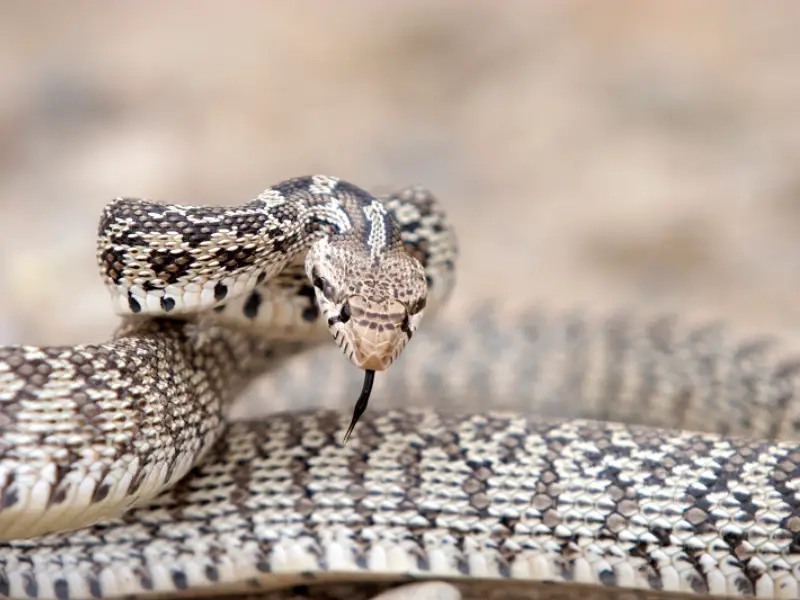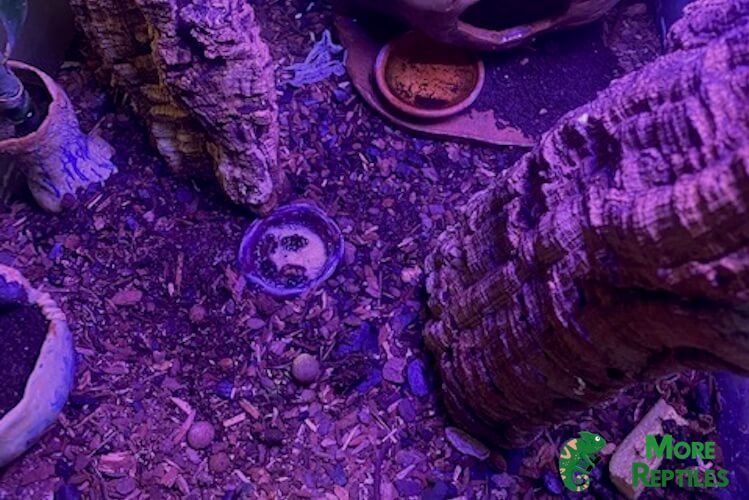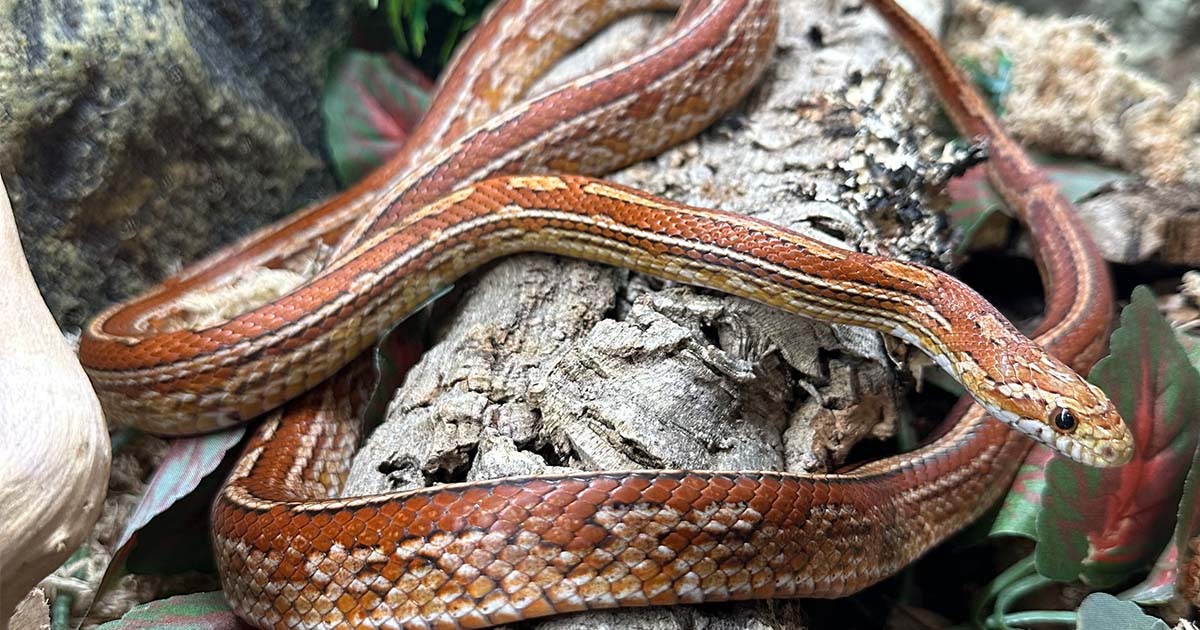Bullsnakes are a subspecies of the Gopher snake and the Pinesnake. Bullsnakes, scientifically known as Pituophis catenifer sayi, are suitable pets for intermediate and experienced snake owners, although they are not recommended for beginners.
Bullsnakes reside in the western, southern, and southeastern United States and are common throughout Texas. In Indiana, they are restricted to the northwestern sand prairie, but their population has slowly dwindled in this area. They are burrowing reptiles and cross land and climb trees in search of prey. They feed mostly on rodents, birds, and lizards.
Due to their burrowing habits, they prefer sandy soil and are abundant in sand prairies, fields, and grasslands. They are also found close to human dwellings, hiding undercover in deserted buildings where they can successfully hunt rodents.
Quick Facts
| Common name | Bullsnake, pilot snake, pine snake, gopher snake |
| Scientific name | Pituophis catenifer sayi |
| Adult size | usually 3-6ft, but can grow up to 8ft |
| Lifespan | 12-30 years |
| Diet | small rodents & insects |
| Tank size | at least 4ft x 2ft x 2ft |
| Humidity & temperature | 82-85F daytime, 72-75F nighttime |
| Popular alternatives | Garter snakes, Russian rat snakes, Hognose snakes |
Bullsnake Species Profile
Physical Attributes & Size
These large, unique, heavy-bodied snakes with a coloration of yellowish-brown or beige with dark, broad striped patterns of brown or black blotches. The head is pointed with dark patches under the eyes. Their bellies are yellowish and have black spots. They range from three to five feet, and adults can grow to over six feet long. Larger species have been recorded of up to 8 feet.
There is very little change in color from the juveniles to the adults. They are almost identical in appearance except for a slight contrast in the patterning.
Lifespan
The lifespan of a bullsnake in captivity can be over 30 years. However, in the wild, they typically live up to twelve years. Unfortunately, in a few areas, for instance, in Wisconsin, there are concerns due to the susceptibility of their natural habitat destruction and illegal captivity for the pet trade.
Conservation And Ecology
These snakes are slow movers and are frequently killed while crossing roads or basking on the roadways. Habitat destruction and road mortality are two concerns for conservationists.
Bullsnakes are categorized as “of least concern” by the IUCN, the body responsible for determining animals’ conservation status.
Hibernation And Habitat
These fossorial (burrowing) creatures spend most of their time underground and yet are snakes of the open country. Their average range of hunting is in the region of 18 acres, but if they become very active, they can expand considerably on this distance.
Mating Habits And Hatchlings
Bullsnakes are egg layers. The females lay their eggs in the burrows they have dug either themselves or leftovers from small mammals. Mating occurs in March and April up to May after hibernation, and she typically lays five to nineteen eggs in loose soil. Their eggs are white, rough with a leathery shell, and average 1½ by 2 inches.
Up to 15 hatchlings will emerge in early autumn after approximately 60 days. The hatchlings are between 10 and 17 inches long and shed their skin at 7 to 10 days of age.
Behavior
Bullsnakes will become defensive if they feel threatened. Their initial reaction is to remain quiet and unmoving. Then, when they perceive they can move away, they will retreat.
Unfortunately, they are not fast movers, and if the threat continues, they will rise up and rear to look as large as possible while hissing at the perceived threat. It will lunge but retreat at the same time as to escape.
Hatchlings tend to bite more frequently than adults if they feel threatened. However, with gentle and frequent handling, a captive snake can become entirely docile and tractable.
Misinformation about the species often results in them being killed. Their coloring, posture, and hissing when threatened can give an impressive resemblance to a rattlesnake. These defensive behaviors are to ward off threats, not to show an attacking stance.
However, in contrast to rattlesnakes, their tails are never elevated in a defensive position; they keep their tails on the ground, vibrating against leaves and plants.
Care Guide
The temperament of a bullsnake varies; some are docile but can be temperamental when defending themselves. They do not like to be handled frequently and will hiss very loudly to warn enemies off and posture themselves into an S-shaped curve. However, they are non-venomous and will only strike when provoked.
Captive pets will seek to hide in substrate-level hideouts or hide boxes and rely on a bowl of fresh water from a pet parent. It also delights in curling up in the water if the bowl is large enough.
Follow this care guide and understand the species profile to become a responsible keeper.
Common Diseases and Disorders
A common cause of injury for domestic bullsnakes is a heater incorrectly installed in a captive cage, which can lead to serious harm.
Although these reptiles love to feed on rodents, a bite from a rodent can be damaging and, in some cases, fatal. Feeding your bullsnake live rodents is never recommended. A rodent bite can lead to mouth rot (infectious stomatitis).
Respiratory disease can occur if the temperature of the cage is not consistent. Keep the humidity at an even level and ensure the cage is never damp. A wet, dirty cage can also cause blister disease.
Improper shedding of its skin will result in a few health concerns, such as retained eyecups, etc. Ensure your snake is properly hydrated for a smooth shedding transition.
Before purchasing and housing a bullsnake, ensure you know a local vet specializing in snakes and reptiles.
Housing
The tank or terrarium should measure at least 4′ x 2′ x 2′, although some adults may require a larger size. Babies should be housed in a tank at least 1′ long.
The bottom should be covered in a layer of cork bark or other suitable material, such as dry mulch or leaves. This will ensure a satisfied pet in a replicated natural environment.
The tank should have a top lockable cover. Heating units and light bulbs should be located at the top of the cage, and away from anywhere the snake might move.
A suitable under-tank heating pad is recommended, and the temperature should be kept at 72 to 75 degrees Fahrenheit at night and 82 to 88 F during the day. You can also supply some suitable furniture, such as smallish branches and rocks, but avoid sharp objects that might puncture the snake’s skin.
Diet And Feeding
These reptiles are powerful constrictors and kill their prey by squeezing. Due to their love of rodents, gophers, and small mammals, wild bullsnakes are considered beneficial to farmers in keeping the pest population down.
Bullsnakes are usually quiet. However, they become active when hungry. You will observe your snake’s activity and know when it is hungry. A good way of determining how much to feed it is to give it a meal that does not exceed the diameter of its head.
They should not swallow something too large, and a sudden fright will cause them to regurgitate a big meal. A hatchling can eat at least one mouse a week; an adult will eat a rat or several mice every week for ten days. Let your snake’s activity patterns tell you when it’s hungry.
At feeding time, approach your pet carefully and slowly to avoid overstimulating them.
If you want to feed it rodents, use pre-killed prey as you do not want your snake to be bitten by the rodent – domestic bullsnakes don’t possess the reflexes to efficiently kill live rodents without being harmed. See diseases and disorders above.
How To Handle Your Snake
It is recommended to always approach from the side, as they are wary of movement from above, especially the juveniles. If they are in the process of shedding, this can also cause impaired vision and frighten the snake, causing it to react aggressively and bite its perceived predator. Snakes react to quick movements, so the slower you are, the better their reaction.
If you need to hold your snake, slide one hand under it and the other hand about a quarter of the way forward from the tail. Work slowly, holding the snake loosely. Do not squeeze tightly, especially if the snake has just fed, as it might regurgitate its meal. It is best to leave the snake for a few days after it has eaten.
Give your hands a thorough washing after handling or even after cleaning the cage to protect yourself from contracting salmonella, a bacterium often carried by amphibians and reptiles.
Keeping a Bullsnake As A Pet
Bullsnakes are appropriate for intermediate and experienced snake handlers. They’re not considered the best choice for beginners – rat snakes and garter snakes are hardier and easier to manage.
The average cost for a bullsnake is $250-$450. As always, verify that you’re buying from a licensed, well-regarded breeder. If you need guidance on where to find and buy from respected breeders, our expert team is always happy to help.
A bullsnake is a beautiful, fulfilling pet, and its long lifespan makes it an enduringly popular choice across the United States.



